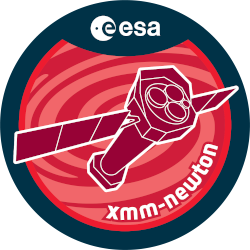

| Proposal ID | 080495 |
| Title | The massive binary HD 93129A: an extreme wind-wind collision during AO16 |
| Download Data Associated to the proposal | https://nxsa.esac.esa.int/nxsa-sl/servlet/data-action-aio?obsno=0804950201 |
| DOI | https://doi.org/10.5270/esa-uun47pd |
| Principal Investigator, PI | Prof Hugues Sana |
| Abstract | With a total mass of over 100Msun, an eccentricity of 0.92 to 0.99 and a periodof ~120yr, HD93129A is one of the most extreme massive binaries known. Newastrometric measurements now predict a periastron passage in 2017, much soonerthan previously thought. The strong stellar winds of the two stars and the tightseparation at periastron will produce an intense wind-wind collision (WWC) andan unusually high thermal and non-thermal X-ray emission. Here we request twoquasi-simultaneous 25ksec XMM and NuStar observations to disentangle the thermal(stellar winds + WWC), dominating below 5keV, and non-thermal (>5keV) componentsfrom the WWC to an unprecedented accuracy. This event is a once-in-a-life-timeopportunity to achieve observational breakthrough in WWC physics. |
| Publications |
|
| Instrument | EMOS1, EMOS2, EPN, OM, RGS1, RGS2 |
| Temporal Coverage | 2017-06-04T20:47:06Z/2017-12-06T14:46:36Z |
| Version | 17.56_20190403_1200 |
| Mission Description | The European Space Agencys (ESA) X-ray Multi-Mirror Mission (XMM-Newton) was launched by an Ariane 504 on December 10th 1999. XMM-Newton is ESAs second cornerstone of the Horizon 2000 Science Programme. It carries 3 high throughput X-ray telescopes with an unprecedented effective area, and an optical monitor, the first flown on a X-ray observatory. The large collecting area and ability to make long uninterrupted exposures provide highly sensitive observations. Since Earths atmosphere blocks out all X-rays, only a telescope in space can detect and study celestial X-ray sources. The XMM-Newton mission is helping scientists to solve a number of cosmic mysteries, ranging from the enigmatic black holes to the origins of the Universe itself. Observing time on XMM-Newton is being made available to the scientific community, applying for observational periods on a competitive basis. |
| Creator Contact | https://www.cosmos.esa.int/web/xmm-newton/xmm-newton-helpdesk |
| Date Published | 2018-12-27T23:00:00Z |
| Last Update | 2025-08-04 |
| Keywords | "XMM", "nonthermal xray emission", "wind wind collision", "periastron passage", "5kev components", "astrometric measurements", "wwc physics", "thermal stellar winds", "stellar winds", "massive binary", "tight separation", "total mass", "life time" |
| Publisher And Registrant | European Space Agency |
| Credit Guidelines | European Space Agency, Prof Hugues Sana, 2018, 'The massive binary HD 93129A: an extreme wind-wind collision during AO16', 17.56_20190403_1200, European Space Agency, https://doi.org/10.5270/esa-uun47pd |